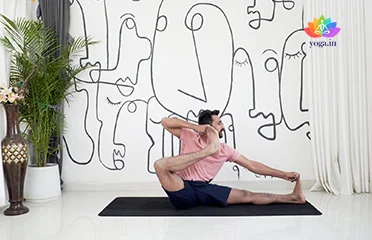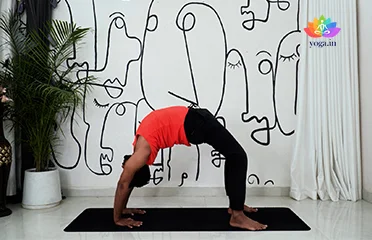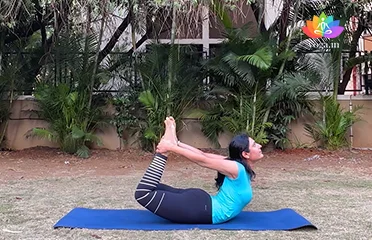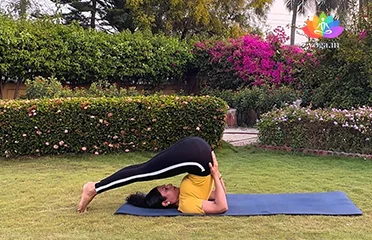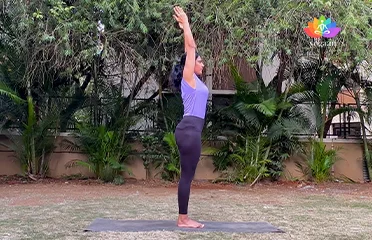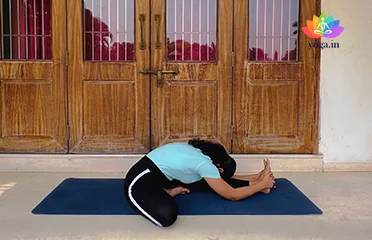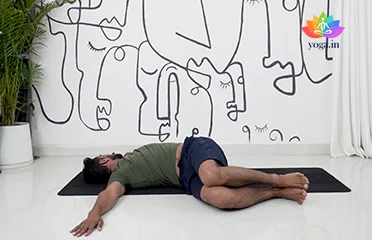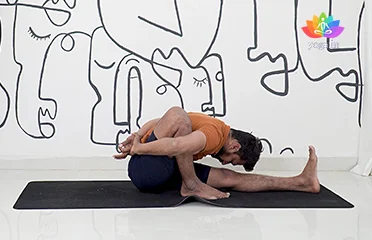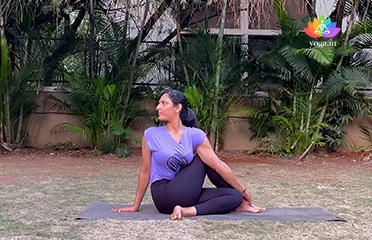Akarna Dhanurasana (Archer Pose)
अकर्णा धनुरासन / Archer Pose
The Sanskrit name is derived from Akarna (अकर्णा ) meaning towards [�K]
Bhujangasana (Cobra Pose)
भुजंगासन / Cobra Pose
The Sanskrit name is derived from Bhujanga (भुजंगा) meaning cobra [�K]
Chakrasana (Wheel Pose)
चक्रासनI / Wheel Pose
The Sanskrit name is derived from Chakra (चक्रा) means wheel and asana [�K]
Dhanurasana (Bow Pose)
धनुरासन / Bow Pose
The Sanskrit name is derived from Dhanur (धनुर) means bow and Asana [�K]
Halasana (Plough Pose)
हलासन / Plough Pose
The Sanskrit name is derived from Hala (हला) meaning plough and asana [�K]
Hastapadasana (Hand to Foot Pose)
हस्तपदासन / Hand to Foot Pose
The sanskrit name is derived from hasta (हस्त) means hands, pada (पदा) [�K]
Janusirsasana (Head to Knee Pose)
जानुशीर्षासन / Head to Knee Pose
The Sanskrit name is derived from (जानु) Janu means knee, Sirsa (शीर्षा) [�K]
Jathara Parivartanasana (The Abdominal T
ञठर परिवर्तनासन / The Abdominal Twist
The Sanskrit name is derived from Jathara (ञठर) meaning belly or abdomen, [�K]
Marichyasana (Sage Twist Pose)
मरीच्यासन / Sage Twist Pose
The Sanskrit name is derived from Marichya (मरीच्) meaning ray of [�K]
Matsyendrasana (Lord of the Fishes Pose)
मत्स्येन्द्रासन / Lord of the Fishes Pose
The name Matsyendrasana is derived from the Sanskrit words Matsya (मत्स्य) [�K]
- 1
- 2
Unveiling Diabetes – Understanding and Managing Blood Sugar
Diabetes is a chronic condition affecting how your body regulates blood sugar (glucose). Two main types exist:
- Type 1 Diabetes: The body struggles to produce enough insulin, a hormone essential for managing blood sugar.
- Type 2 Diabetes: The body either doesn’t use insulin effectively (insulin resistance) or doesn’t produce enough.
Uncontrolled high blood sugar in both cases can damage nerves, blood vessels, and organs over time.
Risk Factors – Unveiling the Causes
While genetics play a role, lifestyle choices significantly influence the risk of developing type 2 diabetes:
- Diet: Excessive sugar, refined carbohydrates, and unhealthy fats can impair insulin’s ability to function properly.
- Physical Inactivity: Regular exercise improves insulin sensitivity and helps maintain a healthy weight.
- Weight: Carrying excess weight increases the risk of developing type 2 diabetes.
- Smoking: Smokers face a higher risk of developing type 2 diabetes and experiencing complications.
- Stress: Chronic stress can elevate blood sugar levels and hinder diabetes management.
- Age: The risk of type 2 diabetes increases with age, especially after 45.
- Family History: Having a close relative with diabetes increases your risk.
- Ethnicity: Certain ethnicities have a higher genetic predisposition to type 2 diabetes.
Symptoms – Recognizing the Warning Signs
Early symptoms of diabetes can be subtle, so regular checkups are crucial. Here are some common signs to watch out for:
- Increased thirst and urination
- Excessive hunger
- Fatigue
- Blurred vision
- Slow-healing wounds
- Unexplained weight loss
Complementary Support – Yoga and Pranayama for Overall Well-being
While not a cure, yoga and pranayama can be valuable additions to a conventional diabetes management plan. These practices may help:
- Improve blood sugar control (research is ongoing)
- Promote stress reduction, which can benefit diabetes management
- Enhance overall well-being and quality of life
Dietary Adjustments – Fueling Your Body Right
- Focus on whole foods: Choose fruits, vegetables, whole grains, and lean protein.
- Limit processed foods, sugary drinks, and unhealthy fats.
- Opt for smaller, more frequent meals throughout the day instead of large portions.
- Monitor and adjust your diet based on your blood sugar levels and doctor’s advice.
Important Considerations: Safety First
- Always consult your doctor before starting yoga or pranayama, especially if you have complications from diabetes or pre-existing medical conditions.
- Modify or avoid poses that cause discomfort or pain.
- Be aware of potential blood sugar drops during practice and have a source of quick-acting carbohydrates readily available.
- Certain poses may not be suitable for everyone. Seek guidance from a qualified yoga instructor to ensure safe practice.
By understanding the risk factors, symptoms, and management strategies for diabetes, you can take charge of your health and well-being. Remember, consult your doctor before starting any new practices, and explore how yoga and pranayama can complement your journey towards a healthier you.


